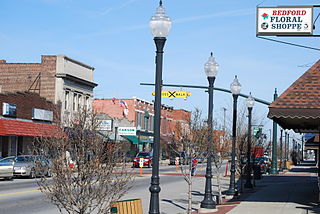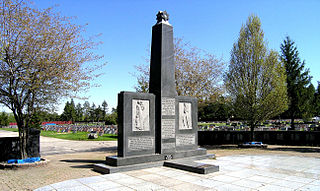
Cuyahoga County is a large urban county located in the northeastern part of the U.S. state of Ohio. The county seat and largest city is Cleveland. As of the 2020 census, its population was 1,264,817, making it the second-most populous county in the state.

Bedford is a city in Cuyahoga County, Ohio, United States. The population was 13,149 at the 2020 census. It is an eastern suburb of Cleveland.

Bedford Heights is a city in Cuyahoga County, Ohio, United States. The population was 11,020 at the 2020 census. A suburb of Cleveland, it is a part of the Cleveland metropolitan area.

Brecksville is a city in southern Cuyahoga County, Ohio, United States. The city's population was 13,635 at the 2020 census. It is a suburb of Cleveland and is included in the Cleveland-Akron-Canton Combined statistical area.

Broadview Heights is a city in southern Cuyahoga County, Ohio, United States. The city's population was 19,936 at the 2020 census. A suburb of Cleveland, it is part of the Cleveland metropolitan area.

Cleveland Heights is a city in Cuyahoga County, Ohio, United States. The population was 45,312 at the 2020 census. One of Cleveland's historic streetcar suburbs, it was founded as a village in 1903 and a city in 1921.

Garfield Heights is a city in Cuyahoga County, Ohio, United States. The population was 29,781 at the time of the 2020 census. A suburb of Cleveland, it is a part of the Cleveland metropolitan area.

Highland Heights is a city in Cuyahoga County, Ohio, United States. The city's population was 8,719 as of the 2020 census. An eastern suburb of Cleveland, it is part of the Cleveland metropolitan area.

Maple Heights is a city in Cuyahoga County, Ohio, United States. It is a suburb of Cleveland. The population was 23,701 at the 2020 census.

Mayfield Heights is a city in Cuyahoga County, Ohio, United States. The population was 20,351 at the 2020 census. An eastern suburb of Cleveland, it is part of the Cleveland metropolitan area.

Middleburg Heights is a city in Cuyahoga County, Ohio, United States. It is a suburb about 11 miles (18 km) southwest of downtown Cleveland. The population was 16,004 at the 2020 census.

North Royalton is a city in Cuyahoga County, Ohio, United States. It is a suburb of Cleveland. The population was 31,322 as of the 2020 census. Originally incorporated as a village in 1927, it achieved the status of city in 1961.

Parma is a city in Cuyahoga County, Ohio, United States, located on the southern edge of Cleveland. As of the 2020 census, its population was 81,144. Parma is the seventh largest city in the state of Ohio, the largest suburb in the state, and the second largest city in Cuyahoga County after Cleveland.

Pepper Pike is a city in eastern Cuyahoga County, Ohio, United States. The population was 6,796 as of the 2020 census. A suburb of Cleveland, it is a part of the Cleveland metropolitan area.

Richmond Heights is a city in Cuyahoga County, Ohio, United States. The population was 10,801 at the 2020 census. A suburb of Cleveland, it is part of the Cleveland metropolitan area.

South Euclid is a city in Cuyahoga County, Ohio, United States. It is an inner-ring suburb of Cleveland located on the city's east side. As of the 2020 census, the population was 21,883.

University Heights is a city in Cuyahoga County, Ohio, United States. The population was 13,914 as of the 2020 Census. Located 8 miles (13 km) from downtown Cleveland, it is a suburb of the Cleveland metropolitan area.

Cuyahoga Falls is a city in Summit County, Ohio, United States. As of the 2020 census, the city population was 51,114. The second-largest city in Summit County, it is located directly north of Akron and is a suburb of the Akron metropolitan area. The city was founded in 1812 by William Wetmore and was originally named Manchester, but renamed for the Cuyahoga River and the series of waterfalls that run along the southern boundary of the city.

The Cleveland metropolitan area, or Greater Cleveland as it is more commonly known, is the metropolitan area surrounding the city of Cleveland in Northeast Ohio, United States. According to the 2020 census results, the six-county Cleveland, OH Metropolitan Statistical Area (MSA) consists of Cuyahoga County, Ashtabula County, Geauga County, Lake County, Lorain County, and Medina County, and has a population of 2,185,825, making it the 33rd-most populous metropolitan area in the United States and the third largest metropolitan area in Ohio. The metro area is also part of the larger Cleveland–Akron–Canton Combined Statistical Area with a population of over 3.7 million people, the most populous statistical area in Ohio and the 17th most populous in the United States.

North Olmsted is a city in Cuyahoga County, Ohio, United States. The population was 32,442 as of the 2020 census. It is a western suburb of Cleveland and part of the Cleveland metropolitan area.























